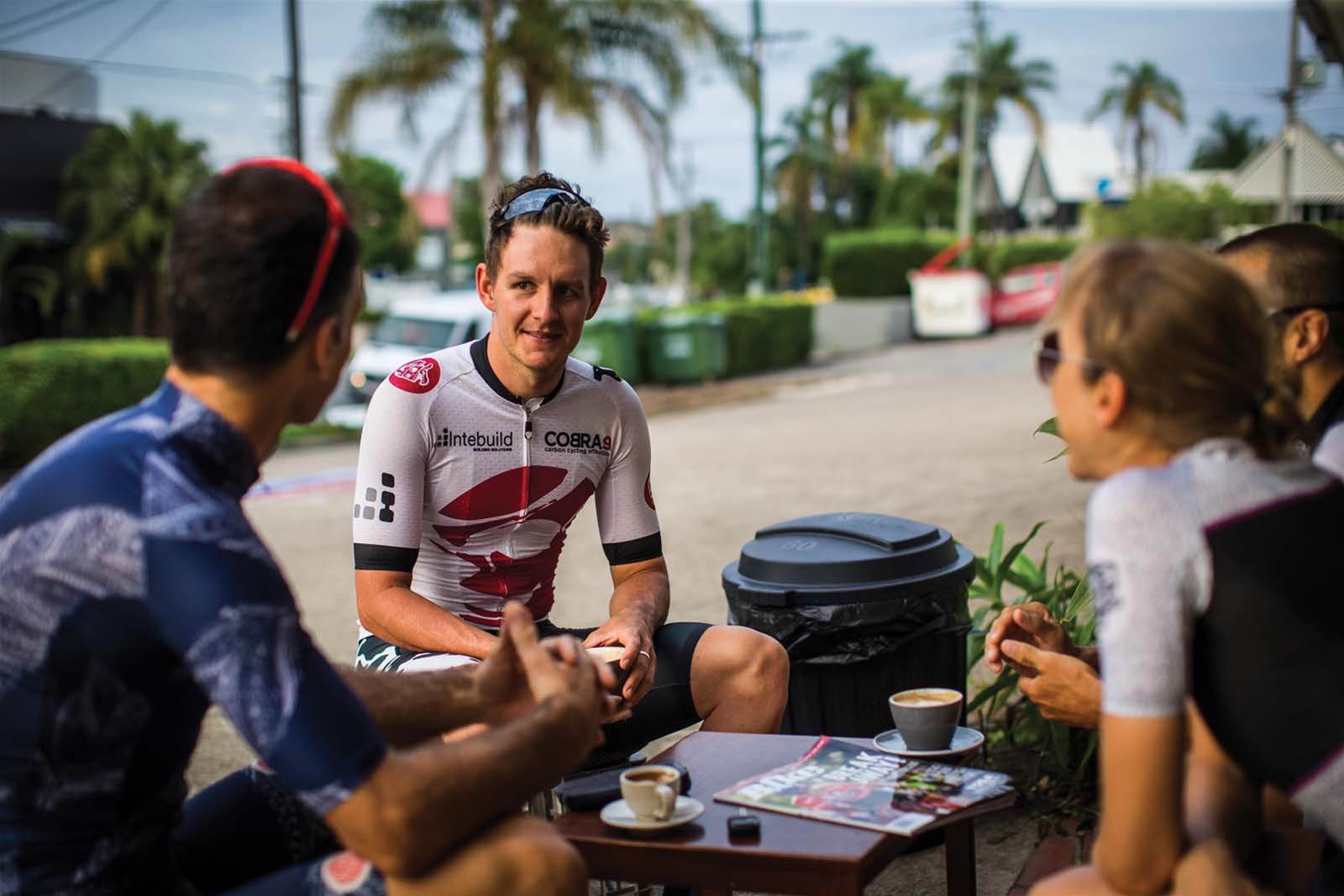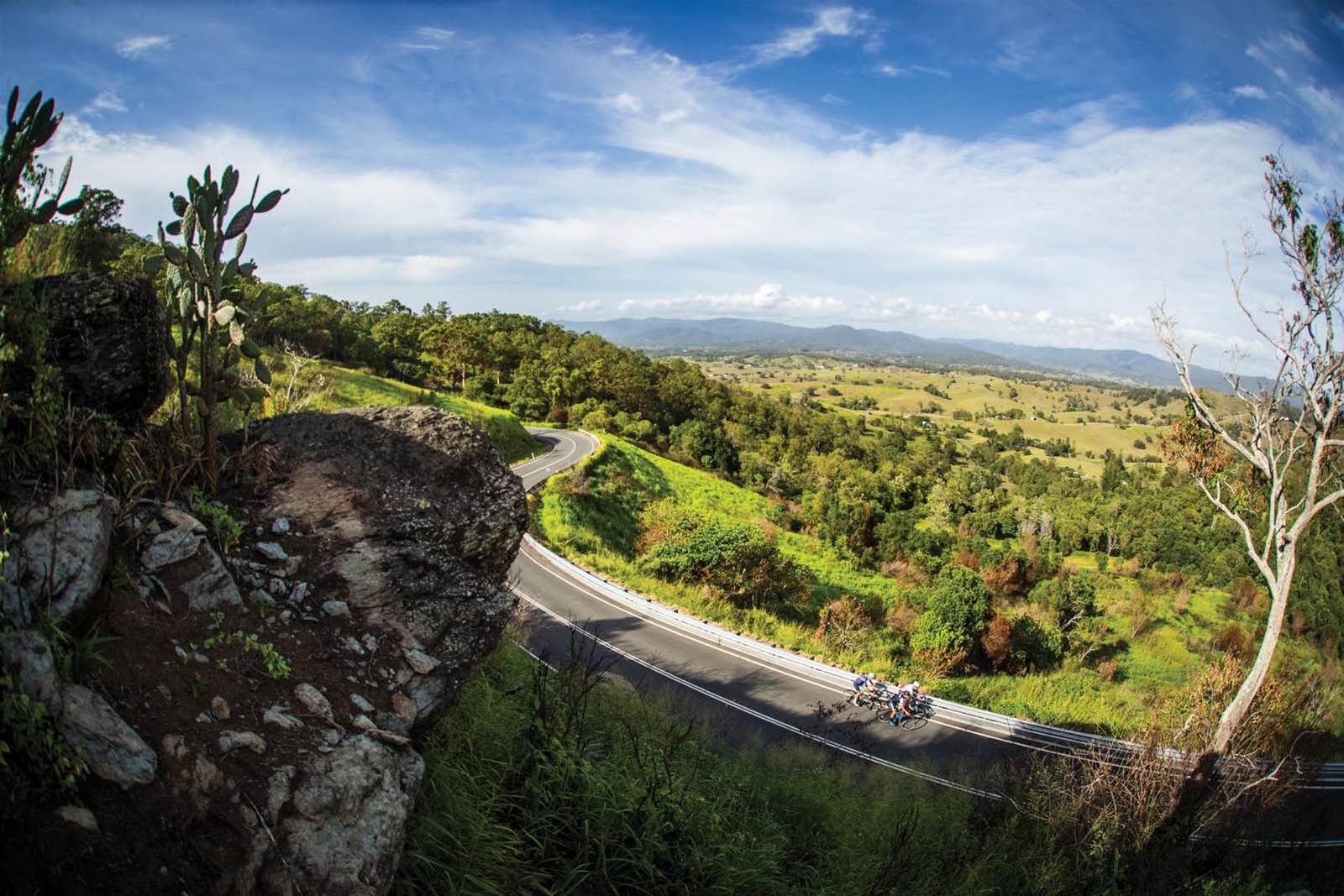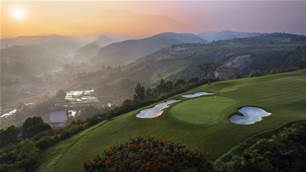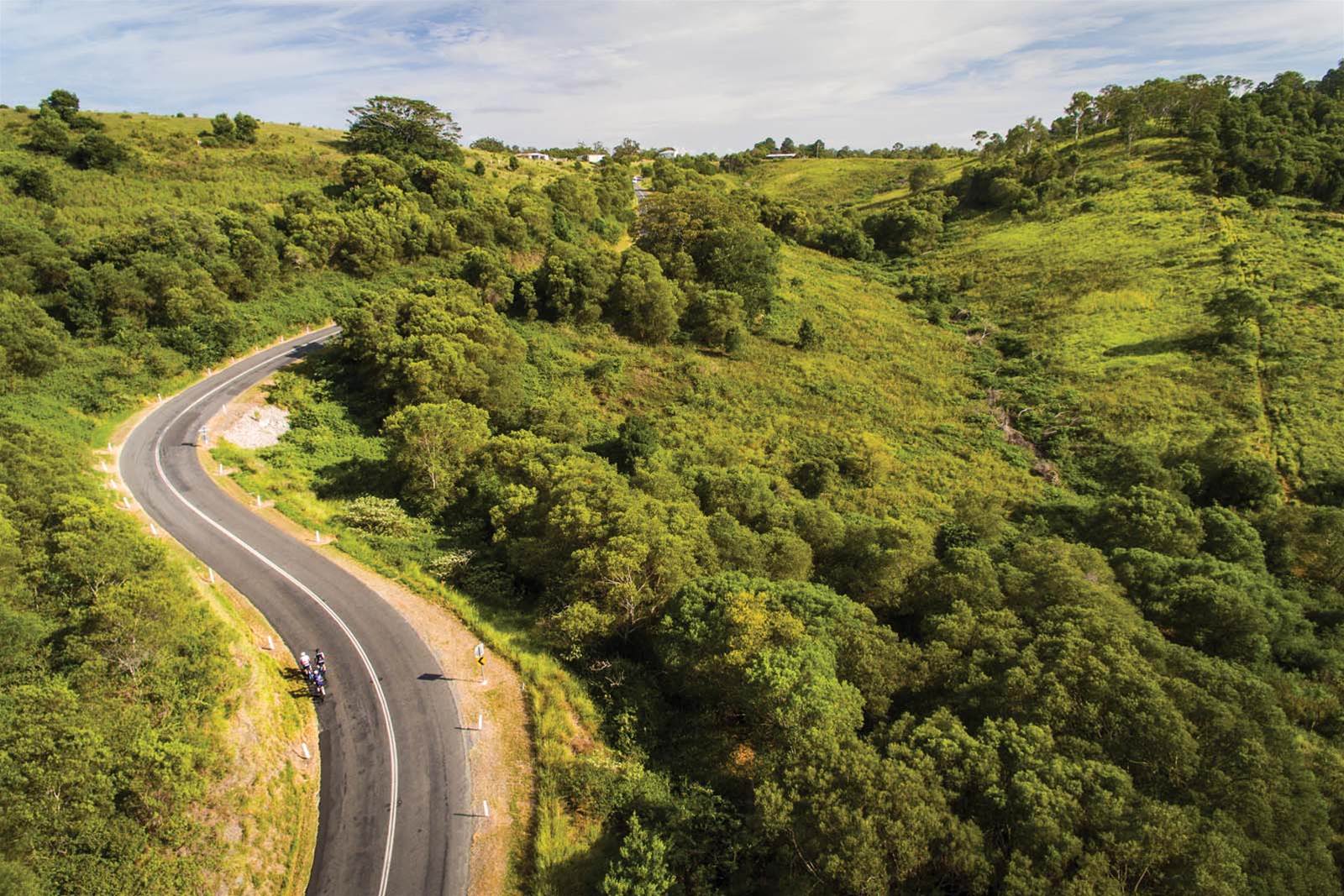Track World Champion Jordan Kerby takes us on one of his favourite rides in the hills beyond Brisbane.
Words: Imogen Smith Images: Tim Bardsley-Smith
Every Wednesday back in the summer of late 2014, a tiny group of elite under-23 riders would leave Brisbane in the pre-dawn cool and head north-west out of the city, climbing over the Samford Range as the sun came up, then pacelining through lush paddocks of hobby farms to the tiny village of Dayboro.
Here they headed up Mt Mee, a steady six kilometre climb, once, twice, three times before turning home without pausing, swapping off all the way. One of those riders was Jordan Kerby. Now crowned Individual Pursuit National Champion on the track, Jordan has a lot of history on the roads of Brisbane, a place whose climate and geography prepared him for competition at the highest level.
“We would meet at 5.30am, ride straight out to Samford, start chopping off, get to the base of Mt Mee, smash out three reps, come down, chop off all the way back into the city for 9.30am”, Kerby explains. “It was preparing for a summer of racing: Nationals, Tour of San Luis, Qatar and Oman. It got me pretty well ready for it – I mean, no matter what you do it doesn’t get you ready for riders who are better than you – but it limits the damage.”
Brisbane, the third biggest city in Australia, isn’t necessarily famous for its cycling. But the Queensland capital has churned out its fair share of champions, including Michael Hepburn, Jay McCarthy, and Kerby himself. Brisbane has a bit of everything: hills, long flat expanses, even mountains, and all of it is wrapped up in a warm, subtropical climate pouring out unlimited sunshine.
It’s not surprising, then, that the city has a pumping cycling culture. People get up early to ride in Brisbane. Really early. By 6.30am the city’s cafés are overflowing with sweaty post-ride lycra. In Brisbane, there’s always time to fit a ride in before work.
Bike visited the river city to meet with Kerby, and the ex-road pro and hugely successful track talent took us on his favourite ride: Over the Samford Range to Dayboro, up and down Mt Mee (just once!), back to Samford, then west and up the unpaved Goat Track, before descending Mt Nebo and back to the city. An epic 130km ride with 2300m climbing.
The Story
We meet at The Pedaler, a boutique bike shop, podiatrist and café in Milton in Brisbane’s inner west, and the base for Jordan’s growing coaching business. The Pedaler is the embodiment of the contemporary cycling scene, with emphasis on bunch rides, workshop, podiatry, coaching, and café before huge expanses of retail space. Instead of the ranges we’re used to seeing, the shop stocks a very limited array of high-end gear and bikes.

We get to know Jordan over coffee. He’s been a successful racer since his early teens, and has raced on more track and road national teams than we could count. More recently he’s done a few tours of duty in Europe on the road, but when Drapac merged with Cannondale at the end of last year Jordan missed out on a place on the team. He’s returned to Brisbane and to the track and, in just a few months, grown a successful coaching business drawing on his years of experience racing at the highest level.
We roll out, heading west. In 2017 Jordan’s mixing the track up with a bit of racing with local team Cobra9, focusing on the Queensland Road Team Series, and a National Road Series race or two. He explains that the workouts he gets in a race usually trump anything he can put himself through in training: “I try to race the criteriums as much as possible. I find there is no better training - you can push yourself to a higher level even if it is a local race than if you go out by yourself and try to do intervals,” he says. “It’s the best way to find shape and if you have to add a few hours either side of the race to make a big day, that works too.”
If Jordan’s looking for “a big day”, this is usually the direction he’ll take. “I usually train on the west side of Brisbane as I find it the quietest and nicest roads out that way. Mt Mee, Goat Track, Brookfield tend to be my favourite rides… I’ve always headed out that way – I don’t really enjoy riding anywhere else, it’s just the best out there. It is uninterrupted and with good climbs.”

We head over the Samford Range, a shortish climb of two or so kilometres at a really pleasant gradient. Jordan, like all cyclists, hates traffic, but there’s a good shoulder heading in this direction and we enjoy the smooth bitumen hill. It’s a fast descent to Samford, the picturesque village of cafés and acreage just outside the city, and we pedal straight through, turning north now. Jordan sets a solid pace over rolling hills, chatting the whole way about his favourite places to ride.
“We’ve done a few camps out of Bright, and that’s spectacular. Rural Victoria is very good – but I do think the best place to ride a bike is Northern NSW,” he says. Still, while Brisbane might lack the beaches and scenery of the Byron Bay hinterland, Kerby says he’d rather be living right where he is than anywhere else, including pro cycling meccas like Girona. “Everything I need is here,” he points out. “If I want to do short punchy stuff I can head to Mt Nebo, if I want to do longer climbs I can head out to Mt Mee, and if I want to do repeats I can just go to Mt Coot-tha. Everything I need from a road perspective is right here in Brisbane.”
As we head into Dayboro we get talking about the track – Jordan has just won the national title in the Individual Pursuit, and at the time of printing is heading to Hong Kong for the UCI World Championships and a shot at the rainbow jersey. For Kerby and a lot of other south-east Queensland trackies, the opening of the Anna Meares Velodrome, built partly for the 2018 Gold Coast Commonwealth Games, has been a huge boost.
“It was great having a homeground advantage on the new velodrome for the National Championships,” Kerby explains. “It’s the first time in years that Queenslanders have been able to train at race pace, on race wheels, with race gearing and at race cadence on a velodrome, instead of an older outdoor track where the conditions are different. It really helps a lot.”

Before the Anna Meares Velodrome opened, Brisbane trackies trained at the Chandler Velodrome, an outdoor cement dinosaur built in 1982. Outdoor velodromes are completely open to the elements, and a concrete track is slow. “If it’s raining you can’t even train – you might head out there for a session and it gets rained out. So the last thing you want to do is go home and get on the ergo and smash it out at 9pm at night. So the new velodrome has put us on an even playing field with every other State really,” says Kerby.
Dayboro is an old-school Queensland country town that’s only just beginning to wake up from its 100-year slumber and take advantage of the weekend drivers and riders who pass through on scenic daytrips from Brisbane every weekend. We head straight through and ascend Mt Mee. It’s a steady climb of six kilometres or so, and definitely one of Jordan’s favourites, although he doesn’t miss the days of three reps at threshold.
While it’s possible to head all the way over Mt Mee and ride on to Woodford or the Sunshine Coast, we do as most Brisbanite riders do and turn around at the top, taking it easy down the smooth hotmix descent before swooping into Dayboro Bakery, the number one stop for carb refuelling on the ride. We buy apple scrolls, cupcakes, cheese and bacon rolls, coffee, sports drink, and home-made doughnuts and sit down for a chat on the wide, sun-drenched verandah.
Jordan opens up about the forthcoming Commonwealth Games and his chances of selection for a very special homeground race. “There’s a lot more involved than just being good at the Individual Pursuit,” Kerby explains. “Where the funding for the National Team comes from, and what it needs to achieve, is to deliver medals at the Olympic Games. So the focus has to be on Olympic Games events.
"So if they were to bring in a rider to the program for something like the Comm Games, it has to be for an Olympic event. They need to develop riders to be successful at the Olympic Games, to continue the cycle. The Commonwealths are here in 12 months, and I’ll put my hand up for it, but there’s a lot that needs to happen before that. I’d have to integrate into the Team Pursuit team if possible.”
We’ve all seen the incredible performances put forward by the Aussie and British pursuit teams at the Olympic Games, and Kerby explains how the battle for gold is changing the riders. “These days they’re almost looking for a sprinter that can go for a long time. The Team Pursuit has become so precise that the riders are becoming a little bit more sprint-based. There is still a huge endurance component, and I don’t know everything about it, but it does look like there’s a trend that it’s coming closer to a sprint event.
"Especially as they are going quicker and quicker. The guys need to be able to get up to 65kmh within a lap, and you need to be pretty strong to do that. The event is getting shorter, and I know the guys spend a lot of time in the gym, a lot of time spent on starts and technique. You never know, 20 years down the track they might be doing 3:30 for four kilometres!”
We haul ourselves back onto our bikes and tap the 20 kilometres back to Samford Village before turning west towards the Goat Track, another of Brisbane’s iconic climbs. Jordan, who says he “couldn’t climb out of bed” is at the velodrome two days a week, and combines this with a couple of ergos and a few sessions on the road a week.

“I go to the track and I do four efforts,” Kerby explains. “About 10 kilometres total of effort, and it’s done. But I leave the track finished. You’d be surprised how much you can hurt yourself in little blocks that only add up to 10 kilometres. Those efforts are so hard to recover from that you need to rest for 15 to 20 minutes just to get ready for the next one.”
It’s a little different from the long drag to the top of the Goat Track. Turning left off the sealed road, we start up the three kilometre gravel grind to the top. Kerby reflects on his time on the road, racing as a talented junior, joining the Under-23 AIS squad, doing stints on the Uni SA team, and enduring an incredibly tough European summer with Cristina Watches. He moved to Pro Continental Drapac Professional Cycling team for 2015 and 2016, racing around the world while basing himself in Girona.
The higher we climb up the white gravel of the Goat Track, the better the views are over the gorgeously green Samford Valley and into the surrounding mountains of these subtropical reaches of the Great Dividing Range. We’re at the top before too long, heading up further still to the village of Mt Nebo, a final café stop for tired riders before the epic 20-kilometre descent (mostly) back to Brisbane’s western outskirts.
Kerby still loves the road, loves getting out on his bike, loves lining up for a race. In just his mid-twenties, he’s seen a lot of racing, such that his role on the growing Brisbane Cobra9 Team will be drawing on his knowledge as they take on some high-level domestic competition.
“I think the best way to guide new riders on the team is within the race,” says Kerby. “That way you can point out when they need to be saving their energy, or when they need to be getting to the front before a certain corner or climb, or where they need to sit within the peloton. My role will mostly involve keeping an eye out and telling some of the less experienced riders what they need to be doing – whether they want to hear it or not at the time.”
We take the descent, sweeping up and down behind Kerby’s wheel before Brisbane city comes into sight and we stop at the first set of traffic lights we’ve seen since the early morning. We ask Jordan if he’d return to Europe, to the pro life so many ordinary cyclists dream of, and so many juniors are working towards, just like he did when he rode 160 kilometres of hills in four hours.
“It would have to be a pretty good pay cheque involved,” he says. “I’m pretty damn happy here. There’s this ideology that racing in Europe is the dream. And it is for a lot of people. But for some people, for one reason or another, it doesn’t work out. I found myself not as happy over there as I am back here, where I have my friends, family, girlfriend and my own place. ‘I have my clear goals on the track, so heading back to the professional peloton in Europe is unlikely. Still you never know.’”
Heading back up the wide, smooth Waterworks Road, Jordan chats about setting up a coaching business associated with The Pedaler - giving something back to athletes from diverse backgrounds and with varying goals. “I’m coaching a range of riders,” he says. “It’s developed really well and I’m getting good feedback. I have a passion for helping people achieve what they want to achieve.
"We’ve got guys doing Ironmans, or people riding seven-day mountain bike stage races, juniors looking to move up the ranks – it ranges from triathletes, to mountain bikers, to crit racers and all different ages too.”
It seems the coaching is the perfect antidote to a career on the road, helping others achieve their goals and shifting the focus away from the individual.
“Being a professional cyclist you can be very, very self-indulgent, and only ever worry about yourself,” says Kerby. “But you have to think about the other people in your life too. It’s not always about you. It can’t just be 'me, me, me, me' the whole time because what happens then? You’re 35, you’ve raced in Europe, and you might not have anyone who loves you back home, you don’t have a family, you don’t have a career.
"Sometimes those things get overlooked. And don’t get me wrong, racing at the highest level in Europe is an amazing thing, an amazing feat and it takes a lot for people to do it and it should be very well respected. But for me at this point of time I don’t think I’ll head back any time soon.”
Hanging out at Brisbane’s vibrant bike cafés it’s easy to see why. The town’s relaxed vibe, access to epic riding, and incredible climate make it a perfect base for talented riders and bike enthusiasts alike.
THE ROUTE
Goat Track: The Goat Track is a one-way, 3km winding gravel road that climbs from Mt Glorious Road up to Mt Nebo Road. While it essentially cuts out the climb to Mt Glorious – it isn’t an easy option. After serious damage in the 2011 floods, the road was reopened in 2014 after extensive drainage work and reinforcements were put in place, making it far more robust than previously.
It is believed the Goat Track was built in the 1920s by returned servicemen, but now you are more likely to see cyclists using the dirt road link on regular training rides. The surface is usually fine for a standard road bike, and it gets graded frequently each year.
The Strava stats
On Strava, the Goat Track is a 3.0km, 8% climb, with a Cat 3 ranking. The Strava segment starts right where you turn off Mt Glorious Road, and not where the gravel starts. This means you have a short little pinch to start with, before being able to get on top of your gear and powering into the gravel section. Depending on how recent the last grading was, prepare for some slower rolling speed once off the sealed road. Once on the gravel the Goat Track is one way, but keep your eyes open anyway.
At about the 2.0-2.5km mark the gradient lifts closer to 10%, so if you want to see how your time fares, leave something in the tank to get through this section, and finish strong! The views from the top over your left shoulder let you see out to Moreton Bay, and once you are on Mt Nebo Road you’re back in typical sub-tropical forest, and can now finish the climb to Mt Nebo.
At time of writing, Samuel Volkers has the KOM up the Goat Track, in a time of 8:52. Lucy Kennedy boasts the QOM title with a time of 10:32.
Mt Mee: The Mt Mee climb heads out from Dayboro, where you turn onto Mt Mee Road from Dayboro Road. The road continues over the top of Mt Mee and through Ocean View, following the ridgeline with views across to the southern part of the Sunshine Coast. This is also a great route if you wanted to ride up towards Mooloolaba or Noosa.
The area was settled in the late 19th century, and became popular for the red cedar that grew in the forests. In time the region became utilised for agriculture, which still continues.
The Strava stats
The Mt Mee climb is rated as a Cat 3 climb on Strava, at 5.7km long with an average gradient of 5%. It is a very consistent gradient, hence it is popular for elite cyclists to train on, and for social group rides too as there is no part of it that feels like you might, in fact, be riding up a wall.
That’s not to say it’s easy, and there are one or two times where you might feel like you are cresting the summit, but you aren’t. The segment itself starts a few hundred metres before the Bond Road turn on the left, and finishes just before the right hand turn to Townsend Road at the top.
The middle section of the climb allows for great views across Dayboro, and although you pass a sign saying ‘Ocean View’, you do need to carry on beyond the crest to truly get a look at the sea. This route is also popular with motorbikes, and it is worth being aware of any other traffic on the road if you are trying to get a ‘PB’ on Mt Mee. Currently, Nick Woods holds the KOM with a time of 12:38, while Lucy Kennedy has the QOM in 14:53.
Samford to Dayboro: Leaving Samford on Main Street, you roll into over 20km of constant pedalling. The road takes you from Samford Village and out through smaller properties to a truly rural Queensland setting. The road takes you past bushland, hobby farms and even a pineapple plantation, with the D’Aguilar Range to your left.
There’s not a whole lot of shoulder once you’re out of Samford, but drivers are used to cyclists on the road. Still, ride single file when you hear traffic, and avoid peak times.
The Strava stats
A look at this road on Strava, and the speeds people maintain, explains a lot. With 23km of pace making, riders are whizzing along at speeds of over 40kmh as an average. There is very little climbing, and a good time along here has as much to do with prevailing wind, and whether there are many cars around.
The fastest on this stretch is David Edwards, who has the KOM with a 28:03, a whopping 49kmh average! The QOM belongs to Ellen Skerritt, in a time of 34:23.
Related Articles

World Exclusive: Trump’s Indonesian Tee-off
International Travel: New kid on the block – Chhun On














